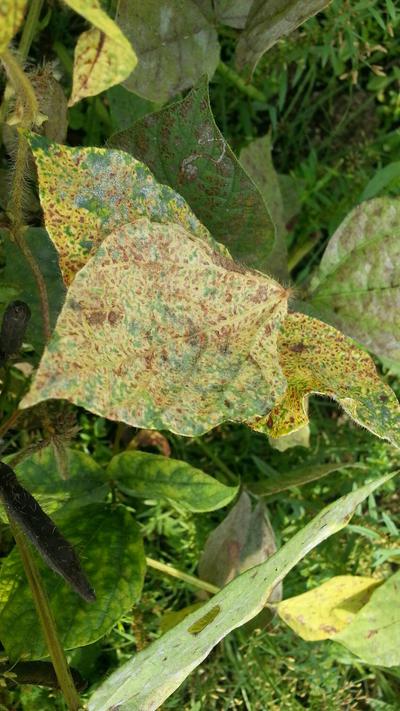Rust on Blackgram
Uromyces phaseoli
Fungus
In a Nutshell
- Small, round reddish-brown pustules appear on the underside of leaves.
- Pustules later merge into larger areas and appear on upper leaf surface.
- Linear, dark brown areas appear later in the season.
- Infection might be visible on petioles, pods and stem.
- Leaves dry, shrivel and fall off, leading to defoliation and yield loss.
Can also be found in
Symptoms
Initial symptoms appear as small, round, reddish brown pustules growing among specks of white fungal growth, usually on the lower surface of the leaf. The pustules can appear in small groups and later merge into larger areas on the leaf blade. Additionally, linear, dark brown areas appear later in the season. Heavy infection can affect the upper leaf surface, resulting in leaves covered by pustules. Leaves become dry, shrivel and fall off. At this stage of the disease, petioles, pods and stems may be affected, too. Intense defoliation results in severe yield losses.
Recommendations

Organic Control
Plant extracts of Salvia officinalis and Potentilla erecta have a good effect as a protective measure against fungal growth once the infection has been discovered.

Chemical Control
Always consider an integrated approach with preventive measures together with biological treatments if available. Chemical treatment may not be viable if the infection was spotted at later stages. If fungicides are needed, products containing mancozeb, propiconazole, copper or sulfur compounds can be used as foliar spray application (usually 3g/l of water). Start the application straight after the first appearance of an infection and repeat it after 15 days.
What caused it?
The pathogen survives in crop debris in the soil or on alternative hosts. Primary infection is by way of spores being splashed from the soil onto the older leaves at the base of the plant. Secondary spreading from plant to plant is wind-driven. The inception of the infection and the dispersal is favored by warm temperatures (21 to 26° C), humid and cloudy weather combined with heavy dews during the night.
Preventive Measures
- Use seeds from healthy plants or certified pathogen-free seeds.
- Plant tolerant or resistant varieties if available in your area.
- Avoid planting alternative hosts in the vicinty of your field.
- Remove alternative hosts and weeds from your field.
- Monitor and remove infected plants parts.
- Ensure crop rotation with non-host crops every three to four years.
- Plow deep and remove plant debris by burning or plowing it.



